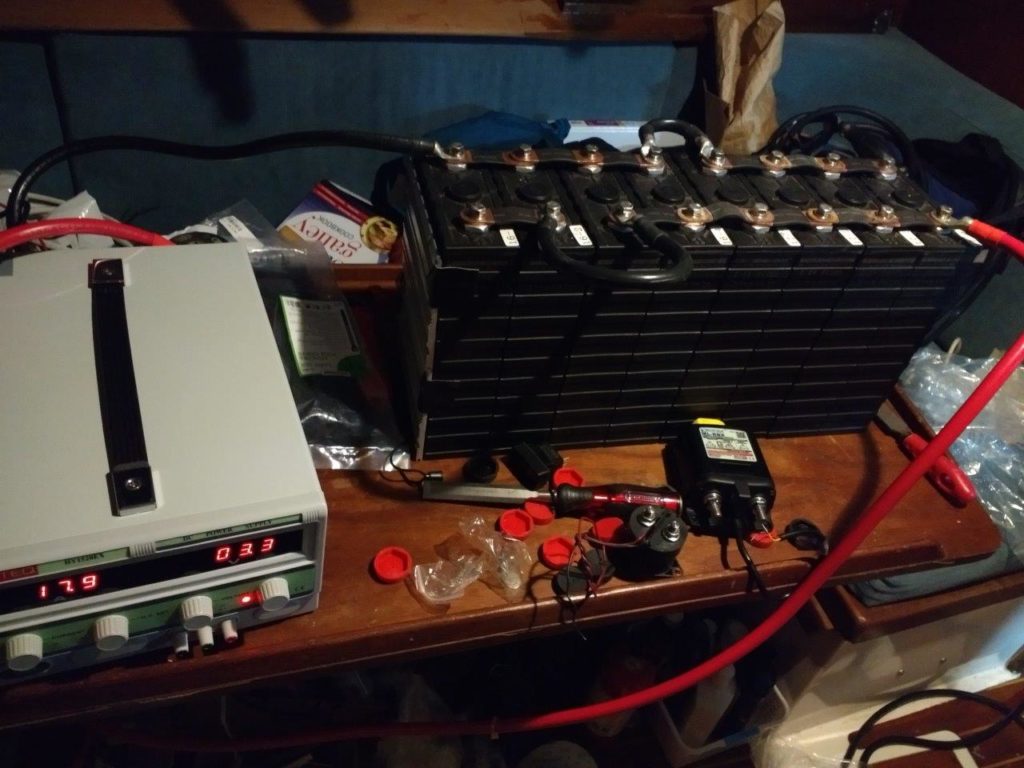Well, after pulling out all the old wiring and running the boat off the DC charger as seen in the last part, the next step was to top balance the LifePO4 pack. I apologise in advance – even by the standards of this lithium series, this is an extremely dry entry. There are only so many light-hearted bon mots you can make about balancing battery cells.
So, top balancing – this is basically making sure all the LiFePO4 cells are at the same level of ‘charge’ (voltage) so that when we put them into a pack together they are all at the same level and won’t do anything weird, like one cell running out of charge way before the others.
LifePO4 cells are weird in that they basically stay at the same voltage throughout an entire charge/discharge cycle, until the end where the voltage falls off a cliff or climbs for the moon, depending at what end of the cycle you are at. And then, if they are kept discharging/charging, they break and it’s a SAD TIME for you and your wallet.
For this reason, (and others) it’s a good idea to top balance a LiFePO4 cell pack before you hook it up. (there is another type of balance where you balance at the bottom end, but that’s more for the electric vehicle guys who will regularly run the batteries right down at high rates of discharge. For a boat house bank, top balancing is the way to go).
The way I did this was buy a lab DC power supply that could hold a constant current or voltage. I got the Volteq HY1520EX which went up to 15 Volts and 20 Amps. There are other ones that go higher and so will charge quicker, but I got this one as it was the cheapest one that did what I want (note it has overvoltage protection – important!), The next one up is the Volteq DC Power Supply 15V 30A
which is the same as the one I used but it goes to 30amps. Less time charging but a bit pricier.
Next, I hooked all the batteries up in parallel, forming one giant 1600AH 3.2 volt battery.
Note I ran out of copper busbar straps, so I had to use 1/0 cable for two links.
Then I set the target voltage for 3.5 volts, and let her rip. I had originally calculated that as the batteries were probably half full, I’d need about 200 amps. At 20 amps/hour using the charger, that would take 10 hours. So I was careful to do this after work so I could keep an eye on it, but by the 4th evening it still wasn’t done and I was confused… until I realised that it had to fill up 800AH, as it was all in parallel. Oops, simple maths error. 1/4 of the way there!
After a LOT of evenings spent hogging my only cabin table, the voltage reached 3.5. I then charged it to around 3.65, while keeping an extremely close eye on it. After 40 hours to go from 3.2 volts to 3.4 it only took an hour to go from 3.4 to 3.65. Once it hit that, I took the power off and waited an hour to see if it stayed above 3.5 volts. I didn’t, so I hit it again up to 3.65. This time, after an hour it was above 3.5 volts, so I hooked up the battery to a circuit, and then discharged it overnight around 100 amp hours. This is important as leaving them at a high state of charge slowly causes capacity loss.
In Summary
So to recap, if you want to top balance your cells:
- Hook up the LiFePO4 cells in parallel
- Charge to 3.45 volts with a regulated DC power supply with overvoltage protection. This part takes FOREEVVVVVVERRRR
- Once it hits that, then adjust the target voltage to 3.65ish. 3.6 or 3.7 also works. Main thing is to keep an eye on the cells for this point, the voltage will rise very rapidly and it’s good not to rely solely on the overvoltage protection feature of the power supply. Check with a multimeter every few minutes.
- Once you hit above 3.6, turn off the power and leave for an hour. Check to see if it’s still over 3.5. If not, charge it up to 3.6 again and leave it for another hour. Repeat until it does.
- Once done, reassemble the pack into a 12volt battery and discharge for a while if you are not going to shove it into the system right away. Storing at a high level of charge is not good for the LiFePO4 cells.
And that’s it! A fully top balanced LiFePO4 battery bank. Now to hook the damn thing up!

Your right a dry topic but great info. Well explained.
Thanks Doug!
Im confused why the voltage will rapidly rise above 3.65V? Shouldn’t it stay there with a benchtop power supply?
Others have said to simply charge to 3.6-3.65V and wait until current tapers down to 0 then your done.
To add to these instructions, FOREVER has an upper limit. In my case, the batteries were clearly shipped at a very low state of charge. 400Ah, charging at 10 amps really did take 40 hours. It took so long, I repeatedly questioned my methods and the health of the batteries. In the end, when FOREVER was reached, the voltage and current behaved exactly as descrobed.
Hah – I also questioned myself repeatedly!